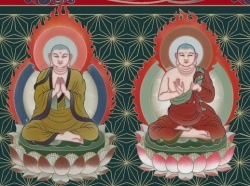Difference between revisions of "Dhammapala"
| Line 1: | Line 1: | ||
[[File:220d36.jpg|thumb|250px|]] | [[File:220d36.jpg|thumb|250px|]] | ||
| − | '''[[Dhammapāla]]''' was the name of two or more great [[Theravada]] [[Buddhism|Buddhist]] commentators. | + | '''[[Dhammapāla]]''' was the [[name]] of two or more great [[Theravada]] [[Buddhism|Buddhist]] commentators. |
| − | The earlier, born in {{Wiki|Kanchipuram}}, is known to us from both the ''[[Gandhavamsa]]'' and the writings of ''[[Xuanzang]]'' to have lived at ''[[Badara Tittha Vihara]]'' south of modern {{Wiki|Chennai}}, and to have written the [[atthakatha|commentaries]] on seven of the shorter {{Wiki|canonical}} books (consisting almost entirely of verses) and also the commentary on the [[Nettipakarana|Netti]], perhaps the oldest [[Pali]] work outside the [[canon]]. Extracts from the latter work, and the whole of three out of the seven others, have been published in [[Pali]] by the [[Pali Text Society]]. These works show great {{Wiki|learning}}, {{Wiki|exegetical}} skill and [[sound]] judgment. But as to the meaning of words, or to discussions of the [[ethical]] import of his texts, very little can be gathered from his writings of value for the {{Wiki|social}} history of his time. Though in all probability a Tamil by [[birth]], he declares, in the opening lines of those of his works that have been edited, that he followed the [[tradition]] of the Great Minister ([[Maha Vihara]]) at {{Wiki|Anuradhapura}} in [[Sri Lanka]], and the works themselves confirm this in every [[respect]]. | + | The earlier, born in {{Wiki|Kanchipuram}}, is known to us from both the ''[[Gandhavamsa]]'' and the writings of ''[[Xuanzang]]'' to have lived at ''[[Badara Tittha Vihara]]'' [[south]] of {{Wiki|modern}} {{Wiki|Chennai}}, and to have written the [[atthakatha|commentaries]] on seven of the shorter {{Wiki|canonical}} [[books]] (consisting almost entirely of verses) and also the commentary on the [[Nettipakarana|Netti]], perhaps the oldest [[Pali]] work outside the [[canon]]. Extracts from the [[latter]] work, and the whole of three out of the seven others, have been published in [[Pali]] by the [[Pali Text Society]]. These works show great {{Wiki|learning}}, {{Wiki|exegetical}} skill and [[sound]] [[judgment]]. But as to the meaning of words, or to discussions of the [[ethical]] import of his texts, very little can be [[gathered]] from his writings of value for the {{Wiki|social}} history of his [[time]]. Though in all {{Wiki|probability}} a {{Wiki|Tamil}} by [[birth]], he declares, in the opening lines of those of his works that have been edited, that he followed the [[tradition]] of the Great [[Minister]] ([[Maha Vihara]]) at {{Wiki|Anuradhapura}} in [[Sri Lanka]], and the works themselves confirm this in every [[respect]]. |
| − | Another writer, probably also called ''[[Dhammapala]]'', since he was supposed by the 12th century to be the same, though [[scholars]] do not accept this, wrote subcommentaries on the commentaries on the ''Digha'', ''Majjhima'' and ''[[Samyutta Nikaya]]s''. | + | Another writer, probably also called ''[[Dhammapala]]'', since he was supposed by the 12th century to be the same, though [[scholars]] do not accept this, wrote subcommentaries on the commentaries on the ''[[Digha]]'', ''[[Majjhima]]'' and ''[[Samyutta Nikaya]]s''. |
A third ''[[Dhammapala]]'' wrote ''[[Saccasankhepa]]'', a handbook of [[abhidhamma]]. | A third ''[[Dhammapala]]'' wrote ''[[Saccasankhepa]]'', a handbook of [[abhidhamma]]. | ||
Revision as of 11:13, 2 September 2014
Dhammapāla was the name of two or more great Theravada Buddhist commentators.
The earlier, born in Kanchipuram, is known to us from both the Gandhavamsa and the writings of Xuanzang to have lived at Badara Tittha Vihara south of modern Chennai, and to have written the commentaries on seven of the shorter canonical books (consisting almost entirely of verses) and also the commentary on the Netti, perhaps the oldest Pali work outside the canon. Extracts from the latter work, and the whole of three out of the seven others, have been published in Pali by the Pali Text Society. These works show great learning, exegetical skill and sound judgment. But as to the meaning of words, or to discussions of the ethical import of his texts, very little can be gathered from his writings of value for the social history of his time. Though in all probability a Tamil by birth, he declares, in the opening lines of those of his works that have been edited, that he followed the tradition of the Great Minister (Maha Vihara) at Anuradhapura in Sri Lanka, and the works themselves confirm this in every respect.
Another writer, probably also called Dhammapala, since he was supposed by the 12th century to be the same, though scholars do not accept this, wrote subcommentaries on the commentaries on the Digha, Majjhima and Samyutta Nikayas.
A third Dhammapala wrote Saccasankhepa, a handbook of abhidhamma.
